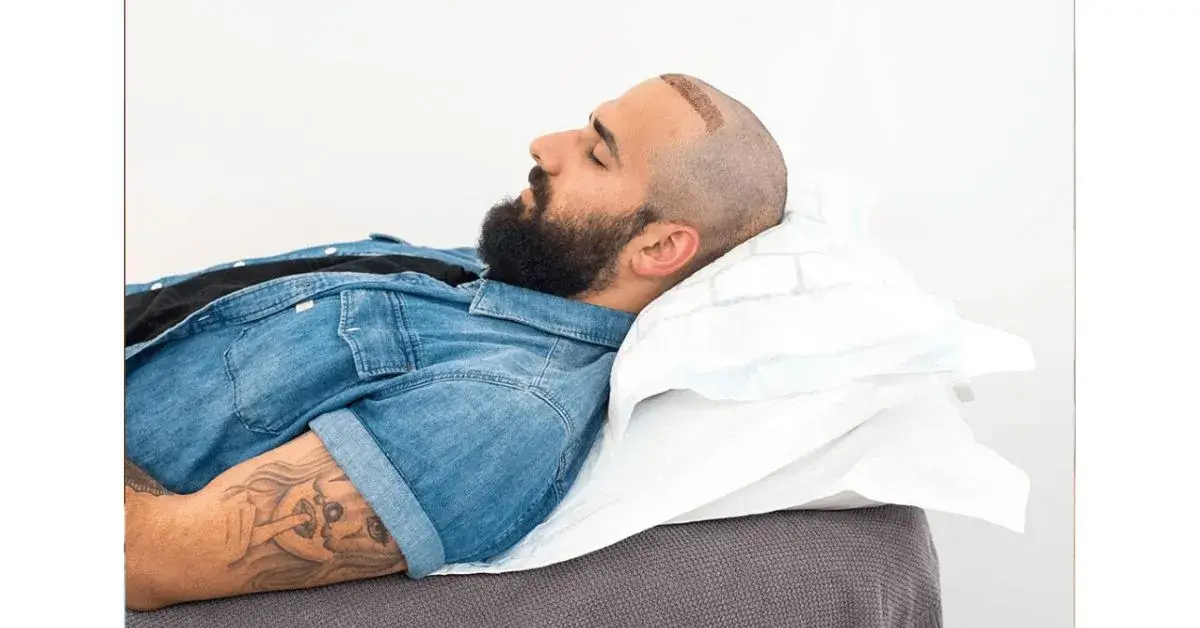As you may know, a Hair transplant is a surgical process; for that reason, you may have to take care of it for a while after the procedure, especially at night.
The area where the donor’s hair was implanted will be reddish and scabbed after a hair transplant. Additionally, the scalp excretes residual local anesthetic during the first night following the transplant. This is a delicate time. You must adopt a specific sleeping position to avoid the skin that is healing from wounds clinging to the pillow and rupturing.
Table of content
What is the ideal sleeping position following a hair transplant?
Wearing a headband for the first five nights will stop the forehead or the area around the eyes from swelling more. You can apply ice to your head if you have swelling, but not to the surgical site. This section must not be touched.
Stay away from flipping over or sleeping on your stomach. Many people discover that lying in a recliner, making sure their head doesn’t touch any surfaces, is a nice way to sleep following a hair transplant.
If your pillows come in contact with the newly transplanted hair follicles, the still-weakly-anchored hair roots could be pulled out once more. If this occurs, the surgery is not only ineffective but could also leave a permanent scar.
Additionally, you should continue to elevate your head by using a neck cushion. You should avoid sudden movements or jolts when sleeping after a hair transplant since they could harm the hair follicles.
When after a hair transplant can I rest comfortably?
Day 0-9: sleep at an angle on your back.
Day 10-14: you may lay on your side try don’t place pressure
Day 14 onwards: Any position is suitable for sleeping.
The Do,s and Don’t,s after the Transplant
- Do s:
- When sleeping for the first two weeks following a hair transplant, keep your head raised.
- Use extra pillows
- Use a travel pillow to prevent yourself from turning
- Don’t,s:
- Turn your head sideways
- Toss and turn when attempting to fall asleep
- Touch your head to anything.
How long does it take for a hair transplant to recover?
Sweaty activities and sporting activities must be avoided as they slow down the healing process and should be reduced to the minimum for the time being after the surgery. This is due to the fact that the sweat that collects on the scalp is a favorable environment for bacterial growth. This increases the chance of the hair grafts becoming infected.
You will return to the clinic for your initial hair wash following the transplant. The hair can be properly rinsed with lukewarm water after three days.
The heat from a hairdryer kills the hair roots, so the scalp should be left to dry naturally in the hair. A moisturizing spray is additionally used on the wound crusts many times each day to maintain their suppleness.
You can wash your hair with a gentle conditioning shampoo after a week. After shampooing, a specific lotion that encourages the growth of the hair roots should be applied and left on for 45 minutes.
You should abstain from alcohol, cigarettes, and highly spiced foods for the first two weeks after the surgery to ensure that blood flow to the scalp is unaffected. The hair will start to grow again strongly three weeks following Dr. Suleyman Tas’ hair restoration procedure.
Start your road toward a hair transplant today. Consult with Dr. Suleyman Tas, the top hair surgeon in Turkey, for free and without obligation.
